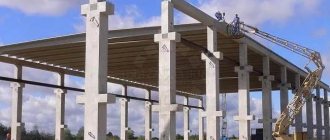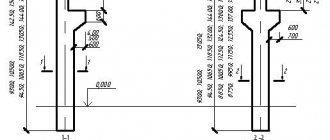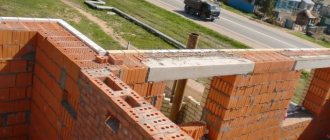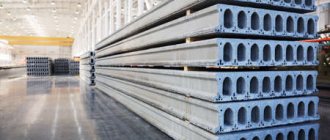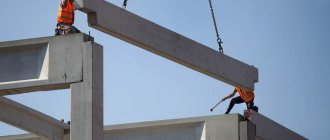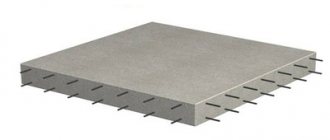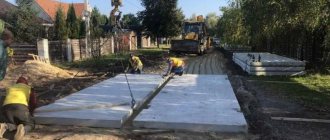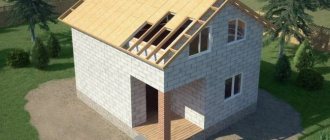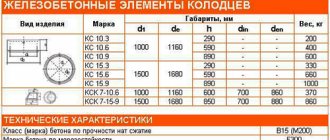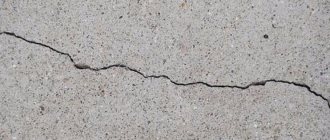- 1 Definition
- 2 Materials and characteristics
- 3 Purpose
- 4 Features
- 5 Marking
- 6 Difference between a crossbar and a beam
- 7 How to make a crossbar?
- 8 Conclusion
Construction has in its arsenal structural elements that allow the construction of openwork buildings. One of the most important products is reinforced concrete crossbars, which bear the weight of floor slabs of multi-story buildings. The reliability and durability of buildings depend on their quality and characteristics. The structural features of these reinforced concrete products are varied, so it is not always possible to see the fundamental differences between the beam and the crossbar.
Elements of the frame-braced structural system of the building
The basis of frame-panel buildings is a prefabricated reinforced concrete frame with vertical stiffening elements (in the form of walls, partitions, cross braces) and horizontal stiffening diaphragms, the role of which is played by discs of prefabricated reinforced concrete floors.
The main elements of the frame-braced structural design of a building are columns, crossbars, vertical stiffening diaphragms and floors: spacer slabs, ordinary slabs (Figure 2.1.a).
The elements of the structural system are summarized in the specification of precast concrete products (Table 2.1).
Table 2.1 Specification of precast reinforced concrete elements
| Brand position | Element designation, element diagram | Name | quantity | Weight, kg | Note |
| 2 KO 3.33 (28) | double console column | ||||
| 2 KO 3.33 (28) | column 1-on cantilever | ||||
| KO 3.33 | 2-cantilever rigidity | ||||
| KO 3.34 | 1-on cantilever stiffness | ||||
| RO 6.90 | crossbar | ||||
| RO 6.60 | |||||
| RO 6.30 | |||||
| RO 6.30 | |||||
| RO 6.60 | |||||
| PC 77-15 | bond plate | ||||
| PC 86-15 | |||||
| PC 57-12 | |||||
| PC 57-15 | wall plate | ||||
| PC 86-15 | |||||
| PC 27-15 | |||||
| LMP 57.11.17-5 | marches combined with half-court | ||||
| LMP 57.11.17-5-3 | march combined with half-court | ||||
| RO 6.30 | staircase transom |
Frame columns
The columns of the frame-braced frame are assumed to be jointless, designed for a height of 2 floors. Columns are used with a section of 300 x 300 mm. Double-cantilever columns are installed in multiple rows with self-supporting external walls and in middle rows with one-sided adjoining walls - rigidity diaphragms in staircases.
Crossbars
Crossbars are the main load-bearing horizontal elements of the frame. The building frames use T-section crossbars with a hollow bottom to support the floor slabs, which reduces the total structural height of the floor.
Depending on the load, two sizes of crossbars are accepted in height - 450 and 600 mm and two in width 520, 360 (depending on the type of overlap of the floor).
Floors
Floor elements are divided into ordinary and braced (plates-spacers). The operation of floors as horizontal stiffening diaphragms is ensured by welding crossbars and columns with bonded floor panels, followed by sealing the seams with concrete.
The main dimensions of the floor elements in width are: two rows of numerous slabs - 1.2 m and 1.5 m; for wall and tie connections – 1.5 m.
The load on the slab is collected in tabular form. For floor slabs, load collection is given in Table 2.2
Table 2.2 Load collection on the floor slab
| Name of structural elements | Standard load, kg/m2 | Load safety factor | Design load kg/m2 |
| 1. Floor construction (linoleum, lightweight concrete screed, soundproofing layer 30 mm thick). Floor height 55 mm. | 1,1 | 38,5 | |
| 2. Slab with large voids | 1,2 | ||
| 3. Partitions (gypsum perlite slabs 100 mm thick, g = 600 kg/m3) | 1,2 | ||
| 4. Payload for classes | 1,3 | ||
| TOTAL | 803,5 |
Without taking into account the slab's own weight, the load is 449 kg/m2, therefore a slab with a load-bearing capacity of at least 600 kg/m2 is required.
For covering slabs, the load is summarized in Table 2.3.
Table 2.3 Load collection on the floor slab
| Name of structural elements | Standard load, kg/m2 | Load safety factor | Design load kg/m2 |
| 1. Protective layer | 1,2 | ||
| 2. Three layers of roofing felt on bitumen mastic | 1,2 | 7,2 | |
| 3. Gypsum perlite screed d = 0.04 m g = 600 kg/m3 | 1,3 | 31,2 | |
| 4. Polyurethane insulation d = 0.16 m g = 80 kg/m3 | 12,8 | 1,2 | 15,36 |
| 5. Reinforced concrete floor slab | 1,2 | ||
| 6. Snow (on an equal area for climate region I) | 1,4 |
Rigidity diaphragm walls
Shear diaphragm walls are floor-high concrete panels that have one- or two-sided cantilever shelves at the top to support the floors.
With a column spacing of up to 6 m, the width of the diaphragm panels corresponds to the clear distance between the columns.
Diaphragm panels are designed as blind or with door openings.
The unified operation of the stiffening diaphragms with the frame is ensured by the welded connection of their elements using embedded parts (Fig. 2.1, b).
GOST requirements
The production, use, storage and transportation of reinforced concrete crossbars is regulated by GOST 18980-2015. They must be manufactured in compliance with the requirements of working drawings and technical documentation. There must be a hole or steel mounting loops for the crane to cling to during loading and installation. The protective layer of concrete from below the beam to the reinforcement must be sufficient. You cannot make it less than what the standard requires.
GOST also regulates the shape of the crossbars. They must be manufactured according to the drawings and the dimensions indicated therein. Deviations are allowed, but no more than the values prescribed in the standard. You cannot install cracked crossbars with a crack width of more than 0.1-0.2 millimeters.
All concrete products produced by factories are tested: several samples are selected from a batch and subjected to a destructive load on special equipment. Also, strength, frost resistance and other indicators are checked using the ultrasonic method.
Storage and transportation is carried out in a horizontal (working) position, in stable stacks up to two meters high, no more than three products in a row in height. Wooden spacers are placed between the floor and the stack, as well as between the crossbars.
What types of beams are there?
Construction beams, like almost all materials used on construction sites, are classified into different types, focused on specific work.
Wooden
The range of beamed wood products used, respectively, in wooden buildings includes logs, crossbars, purlins, crossbars, and other elements that make up the frame of a timber or log residential country house. When dividing floors, floor beams are used. To construct the roof, a beam frame is built, where rafters are used. The main function of wooden beams is to distribute the load evenly along the plane of the top covering (roof). The qualitative characteristics of the material are the key to the strength and stability of the structure.
Reinforced concrete
In construction, the installation of reinforced concrete, for example, in industrial enterprises, takes into account the inclusion of corresponding products in the construction of crane beams, concrete crossbars installed on columns, under floor slabs.
Reinforced concrete beams are a linear type building element. Made from high-quality concrete with steel reinforcement located inside for reinforcement, they are designed to redistribute the load and increase the stability of the main structure.
Metal
Metal structures in construction include horizontal and inclined steel beams as an important part of the rigid frame. More often these are I-beams with parallel edges. Their main types are wide and columnar. The latter are not designed to withstand increased loads, therefore, when installing supporting parts that absorb the influence of the main acting forces, wide-floor beams are used. They are used in the construction of overhead tracks, mine shafts, and so on.
Supports
The beam itself rests on supports. Depending on the design features, the parts are:
- split: two supports support a building element between floors, in the roof of a roof or bridge spans;
- continuous: several supports hold the beam, deflection in one place affects the entire beam load.
Depending on the number of support links, these elements can be classified into types:
- statically determinable: when the number of bond reactions is equal to the number of independent static equilibrium equations;
- statically indeterminate: when the number of connections is greater than the possible equations of static equilibrium.
Cross section as a form of classification
Steel beams can be classified by end section. Such a classification in construction makes it possible to distribute the corresponding elements in the metal assortment and, thus, to select products. For example:
- Rectangular section. Suitable for use in short spans.
- Section type "L". Intended mainly for the construction of building facades.
- Section type "T". Belongs to standard and gable T-beams. They are optimally suited for the installation of medium-length spans.
- I-section. Beams are endowed with increased stability and are used for long spans. In turn, the I-beam can have parallel flange edges. Their parameters vary in accordance with the standards and established GOSTs.
- "V" type section. Such a construction beam plays the role of an additional product to strengthen the supporting structure.
- Section type "VT". Corresponds to purlins.
Thus, hollow supports usually find their use in light constructions of a garage, a small store, or a small shed.
Solid beams are quite suitable for ceilings in the attic of a simple wooden house. Various “T-type options” are designed for more severe loads in multi-storey buildings and industrial buildings. I-beams are the most popular on large construction sites, as they cope well with bending loads in roofing structures. To give them the greatest strength, such beams are produced with a thick wall, with internal edges sloping or parallel.
But trapezoidal horizontal supports are the strongest and most expensive.
Disguise
With this finishing option, everything seems to be clear - you need to make the visually interfering element as invisible as possible. However, in practice, this task often becomes quite difficult. The simplest option is to decorate the parts protruding from the ceiling with the same material as the rest of the plane. However, before finishing, you will have to carefully level the surface of this element so that it looks neat and does not stand out from the general background.
There is another approach to solving this problem. In cases where the height of the interfering parts is small, and the total height of the walls in the room is sufficient, they can be completely hidden behind a suspended or tensioned structure. In this case, the tension fabric or hanging composition is assembled and installed in such a way that the crossbar is completely hidden under the installed decorative fabric of the new ceiling.
Source: wikipotolok.com
DIY curtain clamp pattern
The difference between a crossbar and a beam is as follows:
- A crossbar is a beam that performs a supporting function.
- It can only be installed horizontally.
- The beam works primarily in bending.
- The purpose of the beam is to cover building structures.
- A beam is an independent construction and design element.
- The crossbar is a part of the supporting frame, closely connected with the racks.
- The scope of application of the crossbar is wider.
- It is made from wood, metal and reinforced concrete.
- Beams can be made of wood or metal.
- A crossbar is the core of any structure.
- The beam is the basis for building the frame.
The word "Rim" is German and translated into our language means a crossbar or transverse beam. The name determines the location and meaning of this part.
These structures are load-bearing in the building frame, usually located horizontally.
In ancient times, when there was a need to lock doors, the first foreign locks with a part that pulled out appeared. And since not everyone could purchase such complex locks, they began to use various bolts of varying complexity and they were also called bolts.
Essentially, a deadbolt is a pin or several pins that close the door.
Modern locks have up to six round bolts.
A deadbolt lock is reliable only if it is made of good metal.
The best material for making a crossbar is steel.
A very important nuance is that the response part and the box itself must also be made of very durable materials and installed with high quality.
A single rectangular transom is the simplest. This type of lock is almost never used, and will soon become a rarity.
Crossbar used in construction
In construction, a crossbar is a support, that is, a support beam.
In order to understand where the crossbar is located, you need to imagine a small house with one floor.
A house cannot do without a support beam, which is located horizontally or, in other words, a crossbar.
All important roof structures are attached to the transom. For construction crossbars, the following metal is used. The material for the crossbar is chosen depending on what kind of construction it will be.
A reinforced concrete crossbar structure is used for apartment buildings; for wooden houses, a crossbar made of identical material is used.
The concept of a crossbar and a beam is often confused.
But there are still differences, and they have several points:
- The crossbar is a horizontal support, and the beam is ;
- The crossbar is a rigid fixed support of the frame, and the beam is a bendable structural element;
- For crossbars, materials such as wood, metal and reinforced concrete are used, and for beams only wood and metal are used.
Bridge construction
Reinforced concrete beams are used in bridge construction. Such a horizontal, reinforced concrete structure binds and connects the vertical bridge supports well with each other. Due to the fact that the crossbar is laid from one bridge support to another, this allows the entire massive structure to have rigidity and strength.
Reinforced concrete crossbars are divided into several types according to their intended purpose. All characteristics, sections, requirements for the composition of concrete are determined, the number of which is 13015.0. This standard specifies according to what indicators and under what conditions support parts should be used.
"Rim and Column"
In construction, columns are used to build residential, industrial and non-residential buildings.
This type of construction allows you to get the largest amount of space and this does not depend on the number of floors of the building.
This is called frame construction.
Such columns are produced from such materials as double-cantilever, single-cantilever or without cantilever. Beams and crossbars are connected through a console. This connection occurs using the design features of the crossbar and column, as well as metal mortgages. The installation of the crossbar-column connection is carried out by laying the ends of the crossbar on the connecting pins of the column. To make the connection strong, it is additionally poured
Rigel is a word with many meanings. There are about ten of them. It is called a building element, part of a lock, a jewelry tool, and is also a common German surname. In jewelry, a crossbar is used to straighten, reduce or increase the size of rings or bracelets. The material is steel, often there is a size scale on the tool. It is also used for making chains and other complex products. Jewelry crossbars have different cross-sectional shapes: square, rectangular, round, and so on.
But most often the word “crossbar” is found in less specific areas. The concept closest to every person is the bolt of a lock.
Purpose
Creation of multi-storey structures.
Crossbars connect the vertical structural elements of structures, themselves serving as supports for floor slabs. This function contributes to the formation of rigid spatial strength of the building’s reinforcement, united by welding. Such structures guarantee geometric stabilization of the structure as a whole, transferring the weight of horizontal structures to the supporting vertical “skeleton” of the building. A belt made from such products is capable of raising the base above the foundation to the required height, strengthening and relieving the latter. They are used to assemble structures with wide spans of premises (hangars, trading floors), and to strengthen columns in rooms with high ceilings.
These members are designed to withstand significant loads when laid as beams or used as columns. Reinforced concrete crossbars can be used to form window commissures and fences in multi-storey buildings. In the construction of high-rise buildings and in structures of especially large dimensions, a modification of the crossbar is used, which has a length of 12 m.
This variety has proven to be more reliable than steel samples. Transport infrastructure (fences, parapets, passages, viaducts, bridges, etc.) is actively being constructed using crossbars. In the energy sector, products are used to increase the area of the load-bearing base of power transmission line masts, which allows for horizontal distribution of loads to increase the bearing capacity of the supports.
What can a concrete crossbar look like?
Most often, reinforced concrete crossbars connect the pillars of the building frame. They serve as support for the floors. In this case, high grade concrete is used - from B22 to B60. The choice depends on the number of storeys of the building, and also on the required structural strength. To increase reliability and strength, two reinforcement belts are made. High-strength reinforcement is used. All standards are specified in GOST 13015.3. Technical specifications and standard sizes are specified in GOST 18980-2015.
Excerpt from GOST 18980-2015
Forms and types
Lintels that serve as supports for floors are often called floor crossbars. They come in three types in shape: with one and two shelves or without shelves. Those with one shelf are used along the edges of the structure. Only the edge of one slab can be laid on them. With two - placed in the center. On two shelves you can lay the ceiling on both sides.
- With one shelf (protrusion) - for laying the floor slab on one side. They are also called single-shelf. To support one slab: ROP - hollow;
- ROP - ribbed.
- RLP - staircase;
Types of reinforced concrete crossbars for supporting floor slabs and constructing concrete stairs
- for racks and columns for laying slabs of various types: RDR - ribbed;
- RBR - ribbed;
As you can see, there are crossbars for ribbed and hollow-core slabs. They differ in the strength of concrete, size and strength of reinforcement. The shape matches.
Explanation of markings
The marking contains complete information about the reinforced concrete element. It consists of numbers, Latin letters and Cyrillic alphabet. The designation is divided into blocks using a dash. There can be three blocks in total:
- The first indicates the type of beam, its dimensions in decimeters. The code for the type of bolt can be found in the paragraph above.
- The second block contains information about the type of reinforcement used and the load-bearing capacity in kilonewtons per meter of length.
- The third is information about the concrete used, if it has special properties: increased fire resistance, seismic resistance, tolerance to chemical environments, etc.
Several types of reinforced concrete crossbars with markings and dimensions according to the standard
In general, this topic is extensive, you need to have a lot of tables at hand, since it is unrealistic for a non-specialist to remember all the encodings. Let's look at a few examples - RDP 6.56-110AIV-Na.
- RDP - double-flange crossbar for hollow-core slabs. The dimensions are deciphered as follows: 6.56 - crossbar height 6 dm or 60 cm (600 mm), length 56 dm, this is 560 cm or 5600 mm.
- 110AIV - stands for steel reinforcement made of AIV steel, load-bearing capacity - 110 kN/m.
- Na - the letter "N" - concrete with normal vapor permeability. Letter “a” - additional embedded elements have been added to the design.
Reinforced concrete crossbars must have sling holes or mounting loops for lifting using machinery. Products with unstressed reinforcement can be sold if the concrete strength is at least 70% in warm weather and 85% in winter. Crossbars for interfloor slabs must have a tempering strength of at least 90%. There should be no cracks in the concrete. Small transverse shrinkage hairline cracks with a thickness of no more than 0.1 mm are allowed.
In the context of constantly evolving technologies in the construction industry, new terms and concepts appear, the meaning of which is not always clear to the average person involved only in private construction. Concrete crossbar is one of those words. However, even experienced engineers cannot always clearly explain what this structural element is.
In order to correctly use certain elements in construction, it is necessary to understand their purpose and application features.
Materials and characteristics
The basis of their strength is formed by concrete (heavy weight) of classes (compression) from B22.5 to B60. Reinforcement of products is carried out by metal rod thermomechanically strengthened and hot-rolled reinforcement with a periodic profile, as well as reinforcing steel ropes, reinforced reinforced steel of the prescribed classes and wire of various strengths.
The reinforced concrete crossbar must have the accumulated standard concrete strength, measured at three time points: tempering (70% and 85% in warm and cold times, respectively), transfer, design. Such products have high levels of frost resistance, resistance to aggressive gas compositions, anti-corrosion protection, moisture resistance, and fire resistance.
The finished product has high compliance parameters in terms of: rigidity, crack resistance and strength. Even the dimensions of the tolerances for placing reinforcement outlets (welded with column reinforcement) on the outer surface are standardized - no more than 3 mm. The end connecting plates and rods are firmly connected by welding to the internal axial reinforcement.
Return to contents
Marking
Products are marked with a alphanumeric code, separated by a dash into groups.
Example - RDP 6.56-110AIV. 1st group indicates the type of crossbar, its height in diameter and length (dm), rounded to whole numbers. It is permitted to replace the contents of this group with the name of the product - deadbolt (“P”) indicating the standardized standard size. The second one provides information about the load-bearing capacity (in kN/m) of the product or its serial number in terms of load-bearing capacity. Next, for prestressed reinforcement, the steel class is indicated (Latin letter and Roman numeral). Products marked RDP 6.56-110AIV-Na, for example, in the 3rd group indicate that the material of the product is concrete with normal (“N”) permeability (allowed for use in mildly aggressive gaseous environments), inside which additional embedded elements (“ A"). Crossbars by type are designated by letters: R - rectangular, RO - single-shelf (ROP - for hollow-core slabs, RLP - for flights of stairs, ROP - under, RLR - similar to RLP), RB - shelfless in the form of the letter "T" (RBP - for slabs multi-hollow manufacturing, RBR - for slabs in the ribbed version), RD - two-shelf (RDP - for reinforced concrete hollow-core slabs, RDR - for ribbed slabs) and RKP - balcony (cantilever) for hollow-core slabs. There are crossbars with the manufacturer's abbreviation (according to specifications), taking into account the specifics of their shape, for example, РВ, РМ, AR, etc.
Price
You can purchase a crossbar of the required size at almost any factory engaged in the production of reinforced concrete products. If we talk about the price of the issue, the table below shows the average prices for Moscow and St. Petersburg.
| Name | Marking (size) | Cost per piece, rub |
| RDP | 4.27-60 | 7 000 |
| RDP | 4.27-80 | 10 700 |
| RDP | 4.57-60 | 20 500 |
| RLP | 4.57-40 | 18 000 |
| ROP | 4.27-40 | 9 700 |
| ROP | 4.57-40 | 19 000 |
Products manufactured according to specifications at private enterprises will cost much less. However, the use of such building structures is fraught with consequences.
More about the element
Most often it has a rigid fastening, however, there are cases when in some structures a hinged connection is used. It depends on the purpose of the object.
Single-shelf reinforced concrete structure
You can often hear that construction crossbars are called reinforced concrete beams for structural purposes, which are a horizontal or inclined profile beam.
The dimensions of the reinforced concrete transom can be different, including:
- section;
- form;
- square;
- length;
- method of fastening, depending on the nature of its purpose.
In fact, this is not entirely true, so we’ll talk about how they differ from each other in the last part of the article. Now let’s look at what materials are used to produce crossbars.
The element serves as a support for the floors
Material and parameters
- This structure is made of heavy concrete, the class of which is in the range B 22.5-40. Their output strength must be at least 75% in the warm period, 85% in the cold period, in addition, they must have strict waterproof and frost resistance parameters.
Heavy concrete is used in the production of building elements
- To enhance the reliability of the device, during production they use reinforcement with high-class steel reinforcement of one of two types:
- hot rolled;
- strengthened by thermomechanical influences.
Concrete crossbars - parts of frame construction
- In the manufacture of this building element, GOST for reinforced concrete crossbars is used, which strictly stipulates possible inconsistencies with the established rules. For example, when installing crossbars, it is not allowed for technological holes to be more than 0.1 mm.
Two-shelf prefabricated element
Purpose of the element
The design may vary depending on the parameters and its use. Today there are 3 varieties:
| Single shelf | Designed to support slabs on one side. An example is: staircase; extreme spans of premises. The price depends on the sizes. |
| Double shelf | The product is designed to support slabs on 2 sides. Application: for installation of medium spans. |
| Shelfless | It has a rectangular cross-section and is used for covering slabs of the specified type. |
Floor-less building element for floors
Let's look at the functionality of the element:
- connects parts of load-bearing vertical structures;
- creates spatial hardness of all reinforcement;
- allows you to guarantee the geometric stability of the structure;
- transfers loads from the beam to the support mechanism in a timely manner;
- increases the surface and strength of the concrete foundation;
- supports elements of reinforced concrete structures.
Features of application
The areas of use of crossbars are extremely wide:
- with their help it is possible to erect structures with a collective layout, especially those where high walls and long corridors are expected;
- they are relevant in the process of installing modular structures;
- Precast concrete crossbars for residential and multi-storey public buildings are capable of creating window commissures or fences;
Application in construction - creation of multi-story structures
They are also used as racks in power lines, which increases the area of the load-bearing base, which makes it possible to transfer loads horizontally, increasing the support capabilities.
Peculiarities
The main difference and feature is that the element is able to withstand powerful loads in different directions. For example, work in bending like an ordinary beam, which forms part of the future building as a whole. Typically, such structures are used in the construction of attic spaces.
If the element has a T-shaped section with a bottom flange, they are used to support floor decks. This makes it possible to reduce the size of the part of the structure that will inevitably protrude into the interior by the thickness of the ceiling.
Areas of application
First of all, it is worth paying attention to the design differences of reinforced concrete crossbars, since this will determine for what purposes the product can be used. There are 3 types of these “beams”:
- Single shelf. This L-shaped product is designed to fix ceilings on one side only. Most often, single-shelf “blocks” are used for staircases and in the construction of outer flights of residential and industrial premises.
- The crossbar is two-shelf. This T-shaped structure supports slabs on both sides, making it best suited for medium spans.
- Shelfless. This “beam” has a rectangular cross-section and is mainly used for certain types of floors.
In addition, transom structures are used in the construction of “collective layout” structures, especially if the premises are expected to have fairly high ceilings. Also, products of this type are widely used in modular construction.
In addition, they are used in the creation of window commissures and fences, as well as in the construction of formwork structures.
What is a deadbolt
The crossbar is made of reinforced concrete or wood; it is designed to connect vertical structures and serve as a support for floor slabs. Thanks to these elements, the frame of the building being constructed is formed and the desired geometric shape is ensured.
To cope with the assigned function, the crossbar must meet certain requirements that are prescribed by GOST standards numbered 18980-90. The finished product has the following technical features:
- high resistance to temperature fluctuations;
- neutrality to any aggressive environment;
- high strength, fire resistance and moisture resistance;
- immunity to corrosive changes.
Currently, three categories of crossbars are produced:
| Type of crossbar | Description |
| Single shelf | Made in an L-shape. Designed for one-sided support of floors. |
| Double shelf | T-shaped structure for double-sided support of floor slabs |
| Shelfless | A beam with a rectangular cross-section, used for a specific type of floor. |
In any case, the finished product must have a high degree of rigidity and be resistant to cracks and chips.
What is the difference between a crossbar and a beam |
Construction is developing very actively, and the number of new terms is increasing every day. But in order to apply them correctly, you need to know how one concept differs from another. Not only ordinary people, but also experienced engineers often find themselves at a dead end when they are asked the question of what is the difference between a crossbar and a beam. There is undoubtedly a difference, and this issue remains to be sorted out.
What are crossbars and beams?
A crossbar is a horizontal supporting element to which other supporting structures are attached. The main function of the crossbar is to distribute the load of the rafters onto the beams. Most often it is made of wood, metal or reinforced concrete; the shape of the crossbar depends on this. A beam is a structural element of construction, the main function of which is to work in bending. This is a supporting structure that can be made of wood or metal.
Comparison of crossbar and beam
What is the difference between a crossbar and a beam? When designing building structures, it is important to use terms correctly, since the understanding of the construction process by all workers depends on this
The crossbar can be called a beam, but it should be taken into account that then this beam will become a load-bearing element that will be installed horizontally. Speaking in construction language, a crossbar is a load-bearing beam, which is the basis for the future frame
But the frame is erected using beams. Most often they work in bending, that is, for example, they are used to build an attic space. The beam can be used as a floor between floors. The crossbar is the core of the building structure, and the beam is used to build the frame. The scope of application of the crossbar is wider, since it is the main element of construction. In turn, beams are used exclusively in the construction of buildings and structures as flooring or covering. This feature is also due to the fact that beams are only made of wood and metal, while the crossbar can also be made of reinforced concrete, which significantly expands the scope of its use. Based on the construction process and its inherent terminology, it should be noted that a beam is an independent structural element, which is carefully calculated during design. The crossbar is a part of the frame that is rigidly connected to the racks, and therefore cannot be calculated during the design process. In this regard, the concept of a beam is broader, while the purpose of the crossbar is clearly defined and cannot change depending on conditions. From an etymological point of view, a beam is a broader concept, since a crossbar is the same beam, but performs a highly specialized function.
TheDifference.ru determined that the difference between a crossbar and a beam is as follows:
A crossbar is a beam that performs a supporting function. It can only be installed horizontally. The beam works primarily in bending. The purpose of the beam is to cover building structures. A beam is an independent construction and design element. The crossbar is a part of the supporting frame, closely connected with the racks. The scope of application of the crossbar is wider. It is made from wood, metal and reinforced concrete. Beams can be made of wood or metal. A crossbar is the core of any structure. The beam is the basis for building the frame.
altaiinter.org
SERVICE LIST
MOST DESIGN PROJECTS CONSISTE OF THREE MAIN STAGES: DESIGN, INTERIOR DESIGN AND 3D VISUALIZATION. THE FIRST OF THEM IS THE MOST IMPORTANT, BECAUSE BOTH THE OTHER TASKS AND THE VECTOR OF FUTURE WORK IN GENERAL DIRECTLY DEPEND ON IT. BUILDING DESIGN IS THE CREATION OF A PLAN AND STRUCTURE OF PREMISES. IN OTHER WORDS, AT THIS STAGE THE SQUARE AND SHAPE OF THE ROOMS, THE NUMBER AND LOCATION OF WINDOW AND DOOR OPENINGS ARE MADE.
THE DESIGN FIELD INVOLVES EMPLOYEES FROM DIFFERENT FIELDS: DESIGNERS, ARCHITECTS, DESIGNERS, SECURITY AND COMMUNICATIONS SPECIALISTS. IT IS IMPORTANT NOT ONLY TO DESIGN THE STRUCTURE BEAUTIFULLY, BUT ALSO TO ENSURE THE CORRECT CONDUCT OF ELECTRICITY, WATER, VENTILATION, AND NOT TO DAMAGE THE SUPPORTING STRUCTURES OF THE BUILDING. HOUSE DESIGN SERVICES SHOULD COMBINE INTERESTING DESIGN SOLUTIONS WHILE REMAINING RATIONAL FROM A TECHNICAL POINT OF VIEW.
IN ADDITION TO DESIGNING, WE ARE ENGAGED IN THE CREATION OF INTERIOR DESIGN AND ITS VISUALIZATION. THE LAST SERVICE IMPLIES THE CREATION OF A THREE-DIMENSIONAL DIGITAL MODEL OF THE HOUSING. THANKS TO MODERN TECHNOLOGIES, THE 3D MODEL LOOKS VERY REALISTIC, WHICH ALLOWS YOU TO DISPLAY THE FUTURE DESIGN AS ACCURATELY as possible.
IN THE “PRICES” SECTION YOU CAN READ THE LIST OF SERVICE PACKAGES AND THEIR COSTS. DEPENDING ON THE PACKAGE YOU CHOOSE, DIFFERENT WORK WILL BE DONE, FROM THE LAYOUT OF THE ROOMS TO THE CHOICE OF FURNITURE.
Nuances when calculating beam strength
Calculating the bending strength of a beam means determining the mass data suitable for the beam structure. In this case, the manifestation of any destructive deformations, such as cracks, is not allowed.
The main factors that are taken into account when calculating bending are discussed in more detail above. By highlighting the main points, the following characterizing data is obtained:
- Beam length. Changing it downward increases stability and the ability to withstand increased loads.
- Material of manufacture. Steel is considered the strongest. Next comes reinforced concrete and wood completes the chain.
- Cross section. Calculation of the cross-sectional area gives an understanding of which construction beam is suitable for carrying out certain works.
- Method of fastening in load-bearing structures. This point is closely related to the previous one. The most durable fastening is carried out when installing I-beams.
Crossbar is the name given to metal or wooden floor slabs in construction.
The entire structure has a rigid load-bearing support frame. It is the skeleton, the crystal lattice of buildings, which ensures its static nature and bears the main load.
A crossbar is an important structural detail in construction, a horizontal element connecting supports or racks. Since it is part of the supporting structure, it must comply with technical regulations and GOST.
Let us dwell in more detail on the question, crossbar, what is it.
Functions in construction
Why is a crossbar needed, what is its purpose in construction? It is the basis of the structure, which distributes the load and connects the supports.
Its functions:
- Provides structural rigidity due to horizontal coupling of supporting structures.
- Connects supports and at the same time serves as a shelf for floor slabs.
- Provides rotary (hinge) coupling of vertical support structures.
- Distributes loads proportionally.
- Reduces the construction time of buildings.
- One of the main structural elements in the construction of a structure involving wide, long spans: production workshops, large retail areas, long aisles. It is the horizontal overlap that gives rigidity and reliability to structures.
- Together with supporting structures, it is the basis of the frame of bridges, suspended communications such as viaducts, and high road fences.
- Roof rafters connected by crossbars make the frame rigid and stable.
To summarize, we can conclude that the crossbar is an indispensable structural connecting element for various types of structures. This explains the demand for this type of product. Depending on the purpose and design loads, horizontal beams made of various materials are used.
Main types of crossbars
Among them, the most popular in industrial construction are reinforced concrete and metal horizontal beams. For low-rise buildings, lightweight wooden crossbars are used.
Concrete
Construction concrete beams must meet certain requirements. For example, the presence of a reinforcement cage is required:
- high-quality rolled products that have undergone thermal hardening are used;
- the reinforcement frame consists of longitudinal reinforcement (of different sections), transverse (middle);
- in the supporting parts of the structure there are connecting rods and metal plate elements that are welded to the supports.
Important! Concrete is used only in frost-resistant heavy grades (B 22, B 40), and only minimal deviations from technical dimensions are allowed. https://www.youtube.com/embed/chHRTsEcqnQ
Concrete crossbars are cast in various shapes depending on the purpose. The embedded protrusions on them are called “brands”. The crossbar under the floor slabs is a horizontal reinforced concrete beam having the following shapes:
- rectangular, without protrusions (without shelves);
- with one shelf (L-shaped, single-Tee);
- with two shelves (T-shaped, I-beam).
Not only floor slabs, but also various types of connecting load-bearing metal structures (trusses, beams) are laid on the tees.
Table of markings of crossbars depending on the purpose of the structure and its shape.
| Shape of the crossbar | Marking | Purpose |
| With one shelf (single shelf) | RO ROP RLP ROP | Supports for hollow-core structures (RPS) Flights of stairs (RLP) Ribbed slabs (RPS) |
| Double shelf | RD RDP RDR | Floor slabs Metal structures Hollow-core slabs (RCS), Ribbed slabs (RDR) |
| Rectangular, without shelves | R rectangular RB shelfless RBP RBR | Connections of supports of Hollow-core slabs (HCP) Ribbed slabs (RBR) |
| Balcony or console | RCP | Cantilever structures |
This is marking according to GOST 18980-90. But individual companies can produce crossbars with additional markings according to approved specifications (technical specifications).
GOST crossbar dimensions
| Marking of rectangular crossbar | Width size (mm) | Height size (mm) |
| RV-32-4.5 | 3190 | 160 |
| RV-36-4.5 | 3590 | 160 |
| RV-40-1.3 | 3990 | 160 |
| RV-46-2.5 | 4590 | 380 |
| RV-56-3 | 5590 | 160 |
| RV-60-3 | 5990 | 160 |
| RV-64-3 | 6390 | 160 |
| RV-64-4.5 | 6390 | 160 |
The length is indicated in the second number of the marking.
I-beams
| Marking of double-flange crossbar | Width size (mm) | Height size (mm) |
| 1Р14-12 | 1400 | 400 |
| 1Р20-12 | 2000 | 400 |
| 1Р26-8 | 2600 | 400 |
| 1Р32-8 | 3200 | 400 |
| 1Р38-8 | 3800 | 400 |
| 1Р44-8 | 4440 | 400 |
| R56-12 | 5600 | 400 |
| R56-8 | 5600 | 400 |
| R62-12 | 6200 | 400 |
| R62-8 | 6200 | 400 |
| R74-8 | 7400 | 400 |
| R86-8 | 8600 | 520 |
| RDP 4.26-(40-110) | 2560 | 520 |
Peculiarities
Their designs have different profiles, dimensions (length, cross-section), material, and method of fastening, which is determined by the specific location of application. The cross-sectional shape of the samples is a brand with one or two shelves (for floor slabs), as well as a rectangle and a T-shaped without shelves. The option with one shelf allows you to support slabs on one side (flight of stairs, end bay of a building).
A model with two shelves is supported by two slabs (typical for central spans). T-shaped modifications with a low shelf reduce the visible exit of the structure body into the premises. On rectangular crossbars, the load is simply placed on top. The structural features and purposes of buildings require the use of rigid or hinged methods of fastening crossbars.
Return to contents
